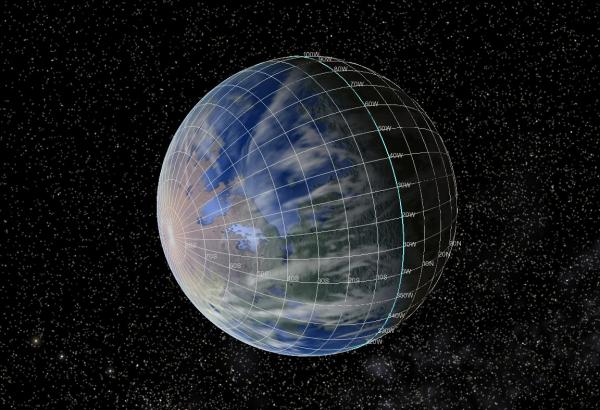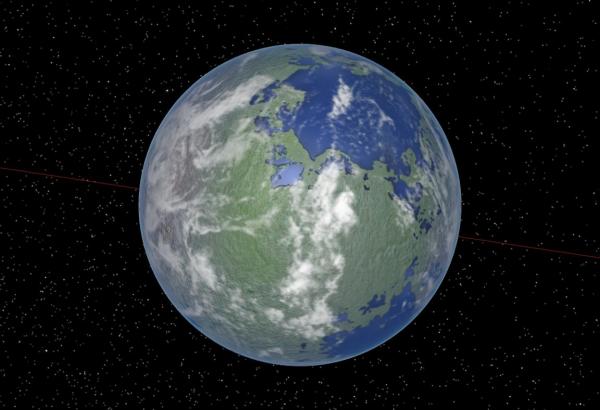BY LETTER
Silenus
Galactography > Regions of Space > Middle Regions/Hinter-regions
Galactography > Sephirotic Empires > Solar Dominion
Galactography > Systems and Worlds > Systems & Worlds S - T
Galactography > Sephirotic Empires > Solar Dominion
Galactography > Systems and Worlds > Systems & Worlds S - T
Solar Dominion colony world with a large axial tilt | |
 Image from Steve Bowers | |
| Silenus- summer in the northern hemisphere | |
Silenus - Data Panel | |
| Star | HD 12820 |
|---|---|
| Constellation | Cassiopeia |
| Distance from Sol | 421 ly |
| Luminosity | 2.04x Sol |
| Planet | Silenus |
| Semimajor axis | 1.5 AU |
| Orbital period | 1.66 standard years |
| Nolwocs classification | Gaian, Skolian subtype (a world with high obliquity, from ancient Greek Skolios, `crooked') |
| Obliquity | 89 degrees |
| Colonised | 3575 AT |
Colonisation
Silenus was first reached by a Truth-Santaya Networks long range probe in 3190; the single terrestrial planet was surveyed and found to be a marginal case for colonisation because of its extreme axial tilt. Nevertheless a colony ship from the Solar Dominion world of Nu Eden finally reached the system in 3575. The HD 12820 system was connected to the wormhole nexus in 3800 at an early stage in its development, as was the practice in the Dominion.Planetology
The planet of Silenus is tilted over so that its rotational axis is almost parallel to the plane of its orbit; this tilt was the origin of the planet's designated name, from the drunken companion and tutor of the Roman god Dionysos. This extreme tilt (obliquity) means that the poles of the world each point directly at the local star at one solstice, while during the periods of the equinoxes the local star can be found above the equator. Worlds like Silenus with high values of obliquity have very different weather conditions during the solstice season as opposed to the equinoctial seasons. Image from Steve Bowers | |
| Silenus- summer in the southern hemisphere, showing local latitude and longitude grid | |
When one pole is pointed towards the star, that pole receives constant solar influx for several months on end; the opposite pole receives no light at all. The pole in summer sunlight becomes very hot, while the winter pole becomes very cold; however there is a considerable transfer of heat from the warm hemisphere to the cold hemisphere via the atmosphere, which becomes very windy in mid-latitudes during this season. Silenus has a long orbital period of 1.66 standard years, so the hot season at the sunward pole is very long; this causes any snow to melt early in the hot season, followed by an almost complete dehydration of the polar region. Water vapour is transferred to the cold hemisphere, where it precipitates as rain or snow. During the long dark months the cold pole receives a considerable amount of snow cover.
 Image from Steve Bowers | |
| Silenus in spring and autumn looks almost like any other Gaian world, apart from the 89 degree axial tilt | |
During the equinoctial seasons the world slowly reverts to a more typical Gaian climate; basic Hadley cells briefly form, before they are once again disrupted by the transequatorial winds at the next solstice. The weather during the equinoctial seasons is unpredictable, but much more clement than during the windy summer and winter periods.
Little can grow at the poles, which have an annual temperature range of 100 degrees Celsius or more; but the mid latitudes get some rain, as the hot winds cool. Some genetically modified species have been introduced which have been designed to survive or thrive at the poles, but the Solar Dominion have never been particularly interested in extreme genemodding, so these species are limited in number.
Silenus is a dry world, with 35% water cover; it was lifeless when first discovered, although some evidence of primordial life has been discovered in the oldest rocks. From stratigraphic evidence it is evident that the planet has not always had such a high tilt, but the planet has had a large range of variation of obliquity over the three billion years since its formation. Planetologists suggest that this variation was probably responsible for the extinction of life less than a billion years after it began.
Culture
Silenus is a world at the fringe of the Solar Dominion, so some of the usual features of Solarian culture are somewhat altered here. The Divine Order is represented by a single Local Guardian, who resides in a stepped pyramid at the sunward pole; when the planet passes equinox the Local Guardian translocates from one pole to another, in a suborbital ISO craft.The high winds during the solstice period mean that almost all agriculture ceases for several months; however the winds represent a useful source of energy, so extensive wind generation systems are in place around the world.
These generally take the form of rotating turbines set into a robust framework, making a continuous fence several hundred metres tall around a particular territory. These turbines can take a number of forms, but are often horizontal, aligned to take advantage of the dominant wind patterns.
Image from Steve Bowers | |
| The wind-fences on Silenus provide power for the civilisation on that windy planet | |
The wind-fences serve to divide the lowland surface of the world up into innumerable small polygons, or tessels as they are known on this world, plots of land which have been fenced off from one another for many millennia. At the centre of each tessel is a settlement, generally underground to avoid the winds. High winds combined with dry conditions are a recipe for severe wildfires on this world, and so any permanent structure is either underground or well-fireproofed.
During the quieter equinoctial seasons the population moves topside into temporary structures resembling yurts. Mountainous regions of Silenus are generally untesselated wastelands, with a few small settlements here and there, often in caves.
These separate tessels each have individual governments, generally based on inherited power. The emphasis on individualism that is at the heart of Solarism has on Silenus been translated into a localized power structure made of innumerable very small self-determining units. Each tessel is subordinate only to the Local Guardian, and in all other matter all of the tessels have equal status. This means that there is considerable local rivalry between the families within their small polygonal territories.
Silenus was not directly affected by the Version War, but the aftermath of that conflict caused the Greater Solar Dominion to withdraw somewhat to its core territories. For several hundred years there was no Guardian in the pyramids of the poles. During this time many of the tessels of Silenus came into conflict with each other, forming power structures and alliances, and short-lived repressive or exploitative empires.
The individual tessels were initially allocated like Thiessen polygons, distributed according to the amount of useful land within each polygon. The communities shared the responsibility for the fence infrastructure with the neigbouring tessels. But the isolated communities began to have border disputes and as a result they would quite often create no-man's lands between their territories, bordered by two fences. Two fences would be slightly less efficient at collecting wind power than a single fence, although this effect would diminish if the fences were further apart, out of each other's wind-shadow. So the fences grew further apart, and so did the communities.
The people of Silenus, like most Solarists, placed great emphasis on self-expression, creativity, and personal self-actualisation of the individual citizen. This meant they were culturally biased against many forms of military teamware technology such as troopminds and group affinity, which were used in many conflicts elsewhere in the Terragen Sphere at that time. Instead the Silenans developed many forms of physical augmentation technology for military purposes and a wide range of weapons designed to be used by individual warriors. Over time a hero culture developed, in some ways resembling the hero culture of the ancient Iron Age of Old Earth. Superstrong armoured soldiers, acting for the most part independently, attacked the fenced territories of their enemies in these low-level conflicts, using a variety of projectile and beam weapons and non-lethal devices for crowd control.
The Summer Combat
When a new Guardian was appointed in 6017, E outlawed all such territorial conflicts; but the local pride of the tessels was running high, so the Guardian formulated an Edict designed to channel this rivalry into more healthy pursuits. A ritualized form of Combat was established at that time, using the supersoldier technology that had emerged during the years of turmoil. Each local year, as the summer solstice winds start to rage, a supersoldier Champion from each tessel in that hemisphere enters the untesselated wilderness regions and fights for the reputation of his home territory. Each Champion may take only as much ammunition and power reserve as e can carry; many different designs of powersuit have been used during these competitions, some extremely heavy, powerful and slow, others faster and lighter. The increasing winds over the Combat period add to the challenge.The Champions were first allowed to use back-up technology in 7099; most take advantage of this opportunity, making the ritual competition a fight to the death in most cases. Since the rules were changed in 9544 to allow magmatter power loops(see power and energy storage article) the ferocity of the ritual combat has increased, and this has brought it to the attention of a wider audience; recordings of the summer Combats are now disseminated throughout the Known Net, in the Dominion territories and beyond.
Related Articles
Appears in Topics
Development Notes
Text by Steve Bowers
Initially published on 29 September 2009.
Initially published on 29 September 2009.






